Brock Barracks Reading
Brock Barracks, Oxford Road in Reading, was built in
1881 and named after the famous Guernsey born soldier. General Sir Isaac
Brock who seceded in saving Canada from an American invasion between 1812
and 1814.
The barracks as of 1878 was used as the regimental depot by the
49th (Princess Charlotte of Wales's) (Hertfordshire) Regiment of Foot
and the 66th (Berkshire) Regiment of Foot known after there amalgamation
as the 1st Battalion, The Princess Charlotte of Wales's (Berkshire Regiment)
and 2nd Battalion, The Princess Charlotte of Wales's (Berkshire Regiment)
respectfully.
During W.W.I and II Brock Barrocks was the administrative home for
all the Royal Berkshire Battalions, and still considered 'home' by a
number of the Burma veterans of the 2nd Battalion The Royal Berkshire
Regiment (Princess Charlotte of Wales's), despite not having been based
there, only during their basic training, as the 2nd Battalion spent the
whole of W.W.II in India and Burma. As of 2005 it was H.Q. to the 7th Battalion
The Rifles, a Territorial Army unit.
A very large part of Brock Barracks surrounding grounds, where rifle ranges and assault courses were sited has long gone. As of 31 March 2004, the overall area of Brock Barracks was some 2 hectares; the total available floor space is 4,325m and the entire site is used for military and cadet activities. The site had also been evaluated at £4.6 million. The future of Brock Barracks remains uncertain.
My thanks and gratitude go out to Sgt. Bob Hope and his commanding officer for the splendid guided tour and allowing me to record such an historic place.
Image 1 - The Keep - Right of the entrance to Brock Barracks. This building contained a large number of classrooms which were used for training and on the battlement-like roof flew the China dragon flag from its mast. click to view
Image 2 - As you pass through the raised barrier you can't help but notice the stone and brick Regimental China Dragon, proudly worn by the Burma veterans. click to view
Image 3 - To the left of the China Dragon is the Regimental office block. click to view
Image 4 - The regimental cenotaph. Designed by Sir Edwin Lutyens, R.A. After the Second World War a new inscription was engraved on the south side of the Cenotaph. Which reads: Re-dedicated, to the Memory of the 9 Officers and 974 Other Ranks of The Regiment who fell in The Second World War, 1939-1945. A more detailed account can be viewed on the memorials page. click to view
Image 5 - After a short walk across the parade ground from the cenotaph stand two large barrack-room blocks, one behind the other. This is the first real sense and feel of what being a soldier would have been like. The first is named Tofrek after a famous battle in 1885, the second Anson. The only reference and mention of Ason was related to me as, Gen. Sir William Anson, Bt., KCB. click to view
Image 6 - The entrance to Tofrek with its two large halls to the immediate right and left. These are now recreation areas but were once used to house the troops, cots and foot lockers lining both sides of the great rooms. click to view
Image 7 - After passing completely through the entrance of Tofrek you emerge out other side, between and directly in front of Anson, (right in this picture). This building is identical to Tofrek only the name sets them apart. click to view
Image 8 - The close up of the entrance to Anson barracks shows you clearly the upper floor. click to view
Image 9 - At the far end of Tofrek and Anson barracks you will find the Senior Officers quarters. One item of interest I immediately noticed was the large heavy metal horse rings attached to some of the walls, a throwback to the days of Calvary and were used to tether their mounts. click to view
Image 10 - The Dragon Club: Once used
as a mess hall for all ranks. Now used for social gatherings and special
occasions. The side room contains a bar, tables and seating just as you
would expect at your local public house.
The main
room
houses
trophy cabinets, with items donated by men and relatives, past and present.
See
below images. click
to view
Image 11 - The entrance hall cabinet contained two of the regiments many drums, sporting the China dragon. Trophies, shields and sashes of achievements, just a few won by the regimental bands over the years. click to view
Image 12 - This cabinet from the side room housed mementoes donated by veterans and wives over the years, too numerous to mention. But the love of the regiment was clear to see, by such items parted with - medal groups for gallantry, documents and papers. click to view
Image 13 - Inside the entrance
hall on the right stood a single large ornate bell, topped by two
Chinthe's, a symbolic guardian of Burmese temples, a mythical beast, half
lion, half-flying griffin.
This bell once stood
outside the guard room at Kalaw in Burma in 1946, (see images Burma Theatre
WWII). click
to view

The Keep
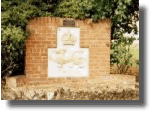
The China Dragon
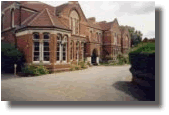
Office Block

The Cenotaph
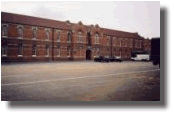
The Parade Ground

Tofrek
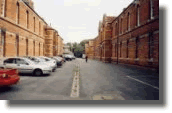
Two Barrock Blocks

Anson Barracks
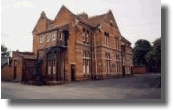
Senior Officers Quarters
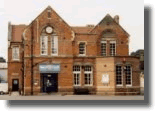
The Dragon Club
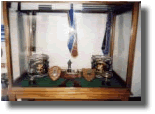
Drums And Trophies Cabinet
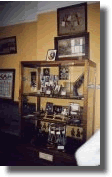
Trophies Cabinet
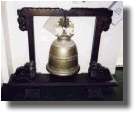
Kalaw Burma Bell
